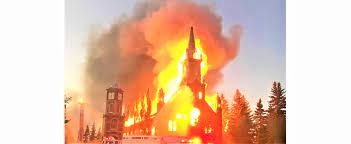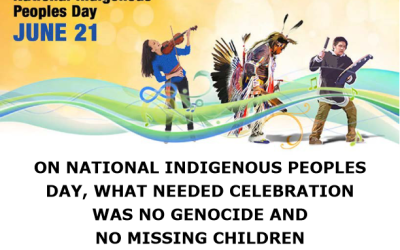Virtually every CBC program and news item about residential schools alleges that “150,000 indigenous children were forced to attend residential schools”. This is false information.
Here is the truth — all of which, as CNN‘s Don Lemon might say, can be Googled.
Some boarding schools (residential schools) for indigenous children predated Confederation. They were religious schools owned and run by Catholic and Protestant denominations. Catholic indigenous parents sent their children to Catholic schools, and Protestant to Protestant. There was no legal requirement that parents do so.
In 1883, the federal government took over the administration of the existing residential schools, and began building new ones. However, the churches continued to run most of the schools, with federal government oversight. There was still no legal requirement compelling status Indian parents to send their children to a residential school, or to any school between 1883 and 1920. Still, many status Indian parents chose to send their children to both day schools and residential schools during that time period.
In 1920 the law was changed to require status Indian parents to send their children to a school. However, if the parents lived in an area that had both a day school and a residential school, the parents could choose to send their children to either a day school or a residential school. Approximately 150,000 indigenous children attended residential schools between 1883 and 1996, while approximately 200,000 attended day schools. This means that slightly more parents chose day schools over residential schools.
It was only in the more remote areas where there were no day schools that status Indian parents were required to send their children to residential schools by law. However, the fact that approximately 1/3 of status Indian children attended no school at all is proof that there was little, if any, enforcement of the attendance laws.
How attendance worked can best be seen in Tomson Highway’s remarkable book, “Permanent Astonishment.” This is Highway’s personal account of his residential school experience — that he described as “nine of the best years of my life”.
Tomson and his family loved their traditional indigenous lifestyle of living off the land in northern Saskatchewan and Manitoba, where they mainly fished for a living. However, the fact that half of Tomson’s siblings had died of pneumonia as babies, because they were born in such harsh conditions, convinced Tomson’s parents that the surviving children must attend a residential school if they were to have a chance at a better future.
They were sent to Guy Hill Indian Residential School, a Catholic school, near The Pas, Manitoba. There, Tomson learned to play classical piano, as well as acquiring the skills that made him one of Canada’s foremost writers and playwrights.
The important point here is that Tomson’s parents were under no legal compulsion to send their children to residential school. They did this of their own accord because they thought it best for their children. The fact is that indigenous parents were as involved as any other parent in matters pertaining to their children’s upbringing and education.
The other important point here is that the Highway family was Catholic, as were most northern indigenous families. They wanted Tomson and his siblings to have a Catholic education. There was no “cultural genocide” involved. They knew what was taught at the school, and could have removed their children from the school at any time. They were Catholics who wanted their children educated in Catholic schools. But mostly they wanted their children to learn to speak, read, and write the English that they did not have.
The Highway family was representative of other indigenous families in remote areas. They wanted what was best for their children. Some of the parents made the painful decision to send their children far away to a residential school. Some of the parents decided not to do that — unfortunately resulting in at least one third of indigenous children receiving little, or no education at all. The decision belonged to the parents. They were not “forced”.
But were some indigenous parent actually “forced” to send their children to residential schools? Only by twisting the meaning of “forced” is the answer “yes.”
In the first place, it can be mischievously argued that every child sent to school by their parents is “forced” to attend school. However, that is not a serious argument. The real argument is whether or not indigenous parents were “forced” to send their children to a residential school. In this regard, we must discuss child welfare systems.
Provinces have formal child welfare systems that allow them to lawfully apprehend children who are not receiving adequate care at home. In cases where a parent is unable or unwilling to provide a proper home for the child, a child welfare worker apprehends their child and finds a safe placement or foster home for the child. That also includes enrolling the child in a school.
The federal government never had a formal child welfare system for the status Indian children for which it is responsible. (Under the Constitution Act Section 92 (14,) status Indians are the responsibility of the federal government.) Instead, the federal government relied on the Indian Agent, who performed a variety of tasks, to identify homes where children were not receiving the proper care — almost always because the parents were debilitated by alcohol — and to remove them, placing those children in residential schools.
In this way, residential schools served as de facto child welfare institutions. (Residential Schools also served as de facto orphanages for the many status Indian orphans). Residential schools increasingly came to serve as child welfare institutions for status Indian children.
So, in these cases, where an Indian agent — usually in consultation with others, such as the chief, the RCMP, the priest etc. — removed the child from the home against the parents” will, it could be said (by twisting words in this way) that these parents were “forced” to send their children to a residential school.
However, in reality, in child welfare situations, where a child has to be removed from the parents’ home for the safety of the child, the parent has already lost their right to make decisions for their child. It is not a correct use of words, therefore, to say that unfit parents were “forced” to send their children, because they had already surrendered their parental rights by virtue of their unfitness. That unfitness almost always took the form of alcohol abuse.
How many of the 150,000 estimated children who attended residential schools between 1883 and 1996 were in this child welfare category, and how many were sent freely by competent, willing parents?
We simply don’t know, because the Truth and Reconciliation Commission chose not to examine this vitally important subject.
However, it can be accurately stated that the claim CBC (and other media outlets) make that “150,000 children were forced to attend” is false.
Brian Giesbrecht is a retired Manitoba judge and Senior Fellow at Frontier Centre for Public Policy



